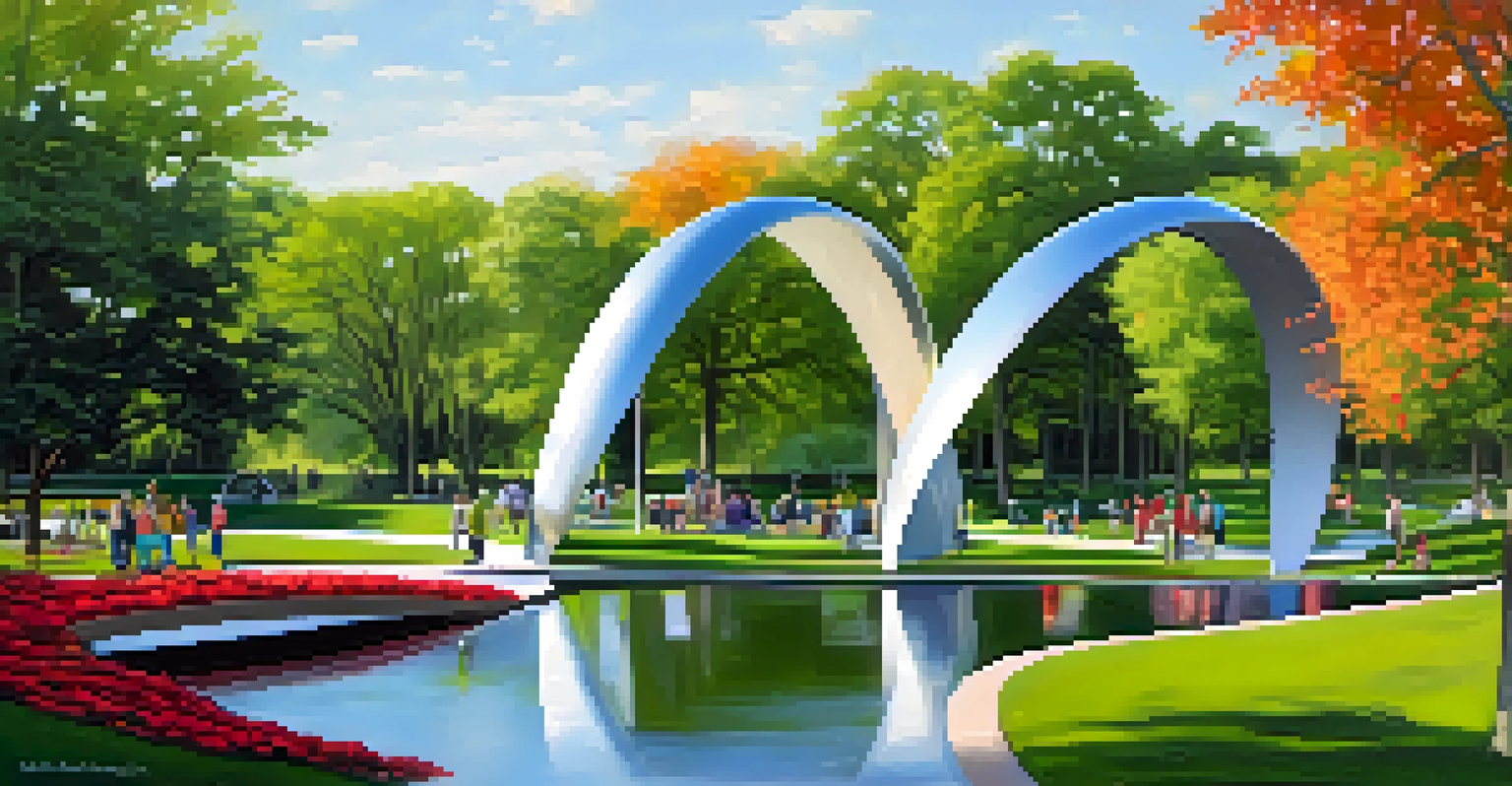Historic Landmarks of Minneapolis: A Look at Iconic Structures

The Stone Arch Bridge: A Historic Engineering Marvel
The Stone Arch Bridge is a stunning symbol of Minneapolis, showcasing both beauty and functionality. Built in 1883, it spans the Mississippi River and was originally used for freight trains. Today, it serves as a pedestrian and biking path, offering breathtaking views of the city and the river below.
Architecture should speak of its time and place, but yearn for timelessness.
This bridge is not just a vital connection between communities; it also stands as a testament to the city's industrial past. Its construction utilized local granite, which gives it a unique charm and durability. Along your walk across the bridge, you can almost hear the echoes of the trains that once rumbled over it.
Visitors often flock to the Stone Arch Bridge, especially during sunset, when the golden hues reflect off the water. Whether you're a history buff or simply enjoy a scenic stroll, this landmark is a must-see when exploring Minneapolis.
Minneapolis City Hall: A Blend of History and Functionality
Minneapolis City Hall is an architectural gem that embodies the city's rich history and civic pride. Completed in 1906, this Romanesque-style building features a striking clock tower that rises 345 feet into the Minneapolis skyline. The intricate details on the facade tell stories of the city’s past and its commitment to public service.

Inside, the grandeur continues with beautiful murals and an impressive Great Hall that hosts various civic events. The building is not only a functioning government hub but also a popular spot for tourists interested in its ornate architecture. Guided tours often reveal hidden gems and fascinating stories behind the building's design and purpose.
Minneapolis's Historic Landmarks
The city is home to stunning architectural marvels like the Stone Arch Bridge and Minneapolis City Hall that reflect its rich history.
The City Hall is often illuminated at night, creating a captivating sight against the starry sky. As you wander around the area, you’ll appreciate how this historic landmark forms a bridge between Minneapolis's past and its vibrant present.
The Foshay Tower: A Tribute to the Roaring Twenties
Rising to 447 feet, the Foshay Tower was once the tallest building in Minneapolis and remains an iconic symbol of the city. Completed in 1929, its Art Deco design reflects the optimism and exuberance of the Roaring Twenties. This skyscraper not only served as a tribute to Wilbur Foshay, a local businessman, but also to the aspirations of the era.
Art is the most beautiful of all lies.
Today, the Foshay Tower houses the W Minneapolis – The Foshay hotel, offering guests a taste of historic luxury. Visitors can take an elevator to the observation deck for panoramic views of the city, making it a popular spot for both locals and tourists. The building’s history and elegance make it a must-visit landmark in downtown Minneapolis.
The Foshay Tower also hosts various events and exhibitions, connecting the past with contemporary culture. When you stand in its shadow, you can’t help but admire how this landmark has adapted over the decades while still holding onto its rich history.
The Guthrie Theater: A Cultural Icon in the Arts
The Guthrie Theater is a cornerstone of Minneapolis's vibrant arts scene, known for its innovative productions and architectural brilliance. Opened in 1963, the theater was designed by renowned architect Ralph Rapson and has since become a cultural icon. Its striking blue exterior and unique cantilevered bridge create a dynamic presence along the Mississippi River.
Inside, audiences can enjoy world-class performances ranging from classic plays to contemporary works. The theater's commitment to artistic excellence and community engagement makes it a staple for both residents and visitors. In addition to its performances, the Guthrie also offers various educational programs to foster a love for the arts.
Cultural and Artistic Hub
Minneapolis boasts vibrant cultural institutions such as the Guthrie Theater and Walker Art Center, showcasing contemporary art and innovative performances.
The building features several stunning spaces, including the Amber Box, which offers breathtaking views of the river and cityscape. Whether you’re attending a show or exploring the theater’s architecture, the Guthrie is an essential stop for anyone interested in the arts.
The Walker Art Center: Where Art Meets Innovation
The Walker Art Center is a premier destination for contemporary art lovers, showcasing a diverse collection that spans various mediums. Established in 1927, the center has evolved into a cultural hub that attracts both locals and tourists alike. Its sleek architecture, designed by Herzog & de Meuron, complements the innovative art within its walls.
Visitors can explore everything from modern art installations to classic sculptures in the center's expansive galleries. The Walker also features an outdoor sculpture garden, providing a unique blend of nature and art. This garden is home to iconic pieces, including Claes Oldenburg's giant spoon and cherry, making it a perfect spot for a leisurely stroll.
In addition to exhibitions, the Walker hosts film screenings, performances, and educational events, fostering a deeper appreciation for the arts. Whether you're an art aficionado or a casual visitor, the Walker Art Center offers something for everyone, making it one of Minneapolis's most cherished landmarks.
The Basilica of Saint Mary: A Spiritual and Architectural Marvel
The Basilica of Saint Mary is a stunning example of Neoclassical architecture and holds the title of the first basilica in the United States. Completed in 1901, this magnificent church features intricate mosaics and soaring domes, making it a breathtaking sight for visitors. Its grandeur reflects both spiritual significance and artistic beauty, drawing people from all walks of life.
Beyond its architectural splendor, the Basilica is an active place of worship and community gathering. It hosts numerous events, including concerts and art exhibitions, creating a vibrant atmosphere that welcomes all. Its location atop a hill provides a serene backdrop, perfect for quiet reflection or exploration.
Nature Meets Art in the Sculpture Garden
The Walker Sculpture Garden beautifully combines over 40 sculptures with serene landscapes, creating a peaceful retreat for visitors.
Visitors can take guided tours to learn about the history and significance of the Basilica, enriching their experience. Whether you’re seeking spiritual solace or simply admiring the craftsmanship, the Basilica of Saint Mary is a landmark that inspires awe.
The Mill City Museum: A Journey Through Minneapolis's History
The Mill City Museum is a unique landmark that offers a glimpse into Minneapolis's rich milling history. Housed in the ruins of the Washburn A Mill, this museum showcases the city's transformation into the 'Flour Milling Capital of the World' in the late 19th century. Through interactive exhibits and engaging displays, visitors can explore the significant impact of the milling industry on the city.
One of the highlights of the museum is the observation deck, which provides stunning views of the Mississippi River and the city skyline. As you walk through the exhibits, you’ll discover fascinating stories about the people and innovations that shaped Minneapolis. The museum also offers guided tours that delve deeper into its history and significance.

The Mill City Museum is not just about the past; it also hosts various events and programs that celebrate the present and future of the city. Whether you're a history enthusiast or simply curious about Minneapolis's roots, this museum is a captivating destination that brings the city's history to life.
The Walker Sculpture Garden: Art in Harmony with Nature
The Walker Sculpture Garden is a true gem in Minneapolis, blending art with the beauty of nature. This expansive outdoor space features over 40 sculptures, including works by renowned artists like Spoonbridge and Cherry by Claes Oldenburg. The garden is a perfect spot for a leisurely stroll, allowing visitors to appreciate both the art and the serene landscape.
Opened in 1988, the garden is designed to engage all senses, creating an interactive experience for everyone who visits. It’s a popular spot for picnics, photos, and casual gatherings, making it a beloved destination for locals and tourists alike. The juxtaposition of monumental sculptures against lush greenery creates a unique atmosphere that’s both inspiring and calming.
In addition to its artistic offerings, the garden often hosts events and programs that encourage community involvement and appreciation for the arts. Whether you’re an art lover or simply seeking a peaceful retreat, the Walker Sculpture Garden is a fantastic place to connect with both creativity and nature.